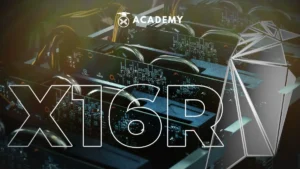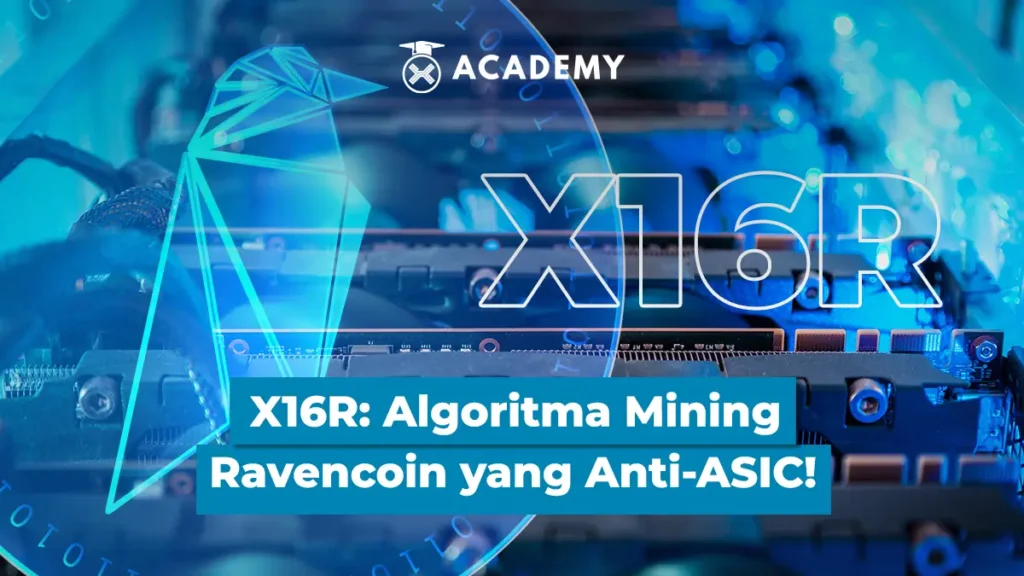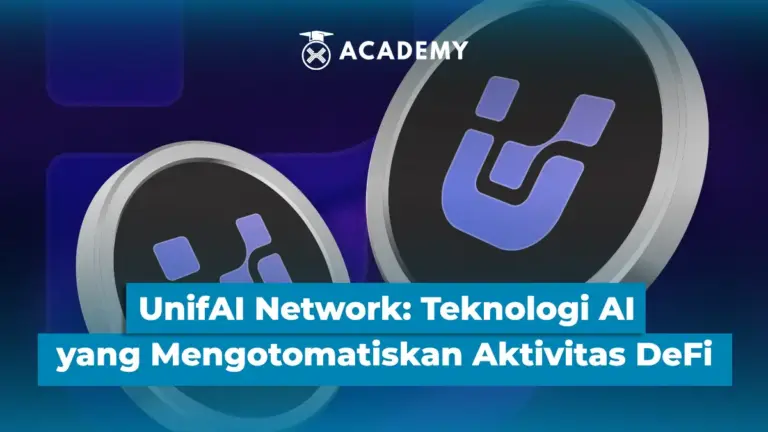In the world of crypto mining, the presence of ASIC devices has marginalized small miners. However, not all algorithms are easily mastered by these devices.
One interesting innovation comes from Ravencoin (RVN to IDR) with the X16R algorithm, which is designed to be difficult to monopolize by ASICs.
This algorithm randomizes the order of the 16 hash functions in each block, creating unique challenges as well as fairer opportunities for GPU-based miners.
However, how does X16R actually work? And why is this algorithm a favorite among Ravencoin miners? Let’s discuss it in the following review.
What is the X16R Algorithm?

X16R is a hashing algorithm developed specifically for Ravencoin (RVN), a blockchain project focused on decentralized digital asset transfers.
It is a derivative of X11—the algorithm used by Dash—but with higher complexity and different design goals.
As the name suggests, X16R consists of 16 cryptographic hash algorithms that are executed sequentially. The order in which these hash functions are executed is not fixed, but randomized based on the hash of the previous block.
In this way, X16R makes the hashing process dynamic and unpredictable, making it difficult to optimize by ASIC (Application-Specific Integrated Circuit) devices.
The main goal of the X16R design is to maintain decentralization in mining by providing a fair chance for GPU miners.
Because ASICs excel at executing fixed and predictable algorithms, X16R’s random approach poses a major challenge for these devices.
This makes ASIC development for X16R much more complicated and expensive, thereby suppressing the potential for monopolization in hashing power.
The X16R has also become a symbol of resistance to the dominance of specialized hardware in the crypto ecosystem, and is a major reason why many GPU miners choose Ravencoin as a fairer alternative.
You might also be interested in this: Get to Know Asic Miner, a Practical Crypto Asset Mining Tool
How X16R Works: An Ever-Changing Hashing Order
X16R is a hashing algorithm originally developed specifically for Ravencoin (RVN), though it is a derivative of X11—the algorithm first used by Dash (DASH).
Like X11, which uses 11 hash functions in sequence, X16R runs 16 hash functions in series, but with a more complex approach to provide resistance to ASICs.
The fundamental difference with X16R lies in the randomization mechanism for the hash function order. Each block on the Ravencoin network has a different hashing order, which is determined by the last 64 bits of the previous block’s hash value.
This value is then divided into 16 4-bit segments, which indicate which hash functions will be used and in what order. As such, the order in which the hash functions are executed changes every time a new block is created.
This approach makes implementing X16R on ASIC devices much more difficult and expensive because there is no fixed pattern that can be optimized efficiently.
In addition, because the order of the hash functions can be different for each block, the GPU’s performance or hash rate will also vary depending on the combination of hashes used.
This means that the GPU can run slower or faster than usual on certain blocks, depending on the complexity of the algorithm formed at that time.
This variation in hash rate per block poses its own challenges for some miners, especially in terms of benchmarking and calculating short-term profits.
However, because the hash order is random and all hash functions in X16R have an equal chance of being used, the average hash rate can still be a reasonable reference in the long term.
Unlike algorithms such as Ethereum or Monero which rely more on the power of GPU memory, X16R is not very memory intensive.
Therefore, miners usually prefer to increase the GPU core clock speed and actually lower the memory clock to save power and reduce heat.
Why is X16R Anti-ASIC?
One of the main reasons Ravencoin adopted X16R was to counter the dominance of ASIC devices, which are known to be able to process hashing algorithms with high efficiency, but only if the algorithm is fixed and predictable.
ASICs are designed specifically for a single algorithm or instruction set, so when the hashing sequence is static, they can be optimized far beyond the capabilities of a typical CPU or GPU.
The X16R specifically breaks this advantage by randomizing the order of the 16 hash functions used in each block. The order is determined by the last 64 bits of the previous block’s hash, making it unpredictable or standardized.
This means that no single ASIC hardware design can consistently optimize for a constantly changing combination of hash functions.
Even if someone tried to develop an ASIC for the X16R, the complexity and cost of producing it would be prohibitively high.
The result would not only be expensive and difficult to distribute widely, but also inefficient in day-to-day operations. That’s what makes the X16R fairer for the GPU and even CPU mining community.
No single entity can easily monopolize hashing power, which helps maintain the spirit of decentralization that is at the heart of the Ravencoin blockchain philosophy.
Other interesting articles for you: How Much Does 1 Mining Rig Make? Here’s the Estimated Income
Impact on Hashrate and Mining Profit
One direct consequence of the dynamic design of the X16R algorithm is the fluctuation of the hashrate on GPU devices. Because the order of hash functions in each block is constantly changing, the difficulty level faced by the GPU also varies.
In one block, a certain combination of hash functions may be lighter, while in the next block it may be harder, depending on the order and type of functions involved.
This variation causes the GPU hashrate to fluctuate from block to block. As a result, conventional benchmarking methods that rely on performance stability become less accurate.
Similarly, short-term profit calculations—for example, calculating daily or weekly revenue estimates—will tend to be inconsistent due to the volatility in GPU workload.
However, in the long run, because all hash functions in X16R have an equal chance of being used, the average hashrate will still form a stable pattern.
A decrease in performance in one block will be offset by an increase in another block. As such, X16R is better suited to miners who think long-term and are prepared for short-term fluctuations.
This approach also strengthens the aspect of decentralization, because it does not benefit those who are only looking for quick and instant profits from mining.
Comparison with Other Algorithms: Ethash & RandomX
Compared to other popular algorithms such as Ethereum’s Ethash and Monero’s RandomX, X16R has a quite different approach in terms of hardware resource usage.
Ethash and RandomX are both designed to maximize memory usage so that both are highly dependent on the bandwidth and RAM capacity of the GPU or CPU.
This is intended to hinder the effectiveness of ASICs because high-spec memory is much more expensive and complicated to integrate into ASIC devices.
Meanwhile, X16R does not burden the memory side too much, but relies more on the core clock speed of the GPU.
Because the sequence of hash functions used in each block is always changing, the device must be able to handle various types of logical computations in a short time, not just processing large data in parallel.
This condition makes Ravencoin miners usually choose to lower the memory clock to reduce power consumption and heat, while increasing the core clock to maintain optimal hashing performance.
This strategy also makes mining with X16R relatively more power efficient, but still requires careful configuration optimization to get the best efficiency.
In other words, even though X16R does not require high memory specifications like Ethash and RandomX, it is still technically challenging and requires a different overclocking approach.
Advantages of X16R for GPU Miners

X16R offers several key advantages that make it very attractive to GPU miners, including the following:
1. Anti-ASIC
This algorithm is designed to minimize the dominance of expensive and unaffordable ASIC hardware for ordinary miners.
2. Fair and open
With an ever-changing hash function sequence, every small miner has an equal chance to compete in the mining process.
3. Dynamic
The randomization of the hash function sequence keeps the network decentralized and avoids monopolization of hashing power.
4. Energy efficient
Because it is less memory-intensive, X16R allows GPU rigs to operate with efficient tuning, such as lowering the memory clock to reduce power consumption and heat.
Conclusion
Well, that was an interesting discussion about X16R: Ravencoin’s Anti-ASIC Mining Algorithm! which you can read in full at the Crypto Academy at INDODAX Academy.
In addition to expanding your investment horizons, you can also stay updated with the latest crypto news and directly monitor the price movements of digital assets on the INDODAX Market. Don’t forget to activate notifications so that you always get the latest information about digital assets and blockchain technology only at INDODAX Academy.
You can also follow our latest news via Google News for faster and more reliable access to information. For an easy and safe trading experience, download the best crypto application from INDODAX on the App Store or Google Play Store.
Also maximize your crypto assets with the INDODAX Earn feature, a practical way to earn passive income from the assets you store.
In conclusion, X16R is here as an innovative solution that proves that mining activities can remain fair and inclusive even amidst the growing dominance of ASIC devices.
Don’t forget to follow our social media here: Instagram, X, Youtube & Telegram
FAQ
1.What is X16R?
A crypto mining algorithm based on 16 hash functions whose order changes in each block. Designed anti-ASIC.
2.What coins is X16R used for?
X16R is specifically designed for Ravencoin (RVN).
3.Why is this algorithm anti-ASIC?
Because the hashing order always changes based on the previous block, making the ASIC design inefficient.
4.What is the impact on GPU mining?
Fairer for GPU miners, although the hashrate can fluctuate each block.
5.Is X16R suitable for beginners?
Suitable if you understand the basics of GPU mining and want to find a more open and cost-effective algorithm.
Author: Boy






 Polkadot 8.91%
Polkadot 8.91%
 BNB 0.54%
BNB 0.54%
 Solana 4.81%
Solana 4.81%
 Ethereum 2.37%
Ethereum 2.37%
 Cardano 1.35%
Cardano 1.35%
 Polygon Ecosystem Token 2.11%
Polygon Ecosystem Token 2.11%
 Tron 2.85%
Tron 2.85%
 Market
Market


